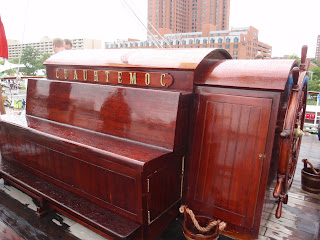 |
| Historical reenacting is a somewhat unlikely hobby for someone who lives on a boat, but there's an obvious link to nautical history and education. Little boys, though, are all about the swords! (Photo by Cindy Wallach) |
You can learn a lot about someone, when you learn how he/she
spends his/her free time.
Living and traveling on a boat, much of our time is spent
navigating, looking at the natural world around us. Or exploring port towns we stop in. Or doing boat chores, oiling the teak or
trimming the sails or scrubbing the bottom.
Still, not all of our time is spent on the business of everyday (boat)
living. There’s still plenty of time for
hobbies.
I read about this fun
blog hop: once a month, a
varied group of liveaboard bloggers agree to write about a given topic so
readers can get multiple points of view on a subject by visiting the
blogs. I enthusiastically agreed to
participate without the faintest idea what I was going to say. Sailing was my “hobby,” but now that we live
aboard a boat fulltime, it’s my everyday life.
Is living in a house a hobby, for people who live on land?
The hobbies one can take up on a boat are limited by the
fact that you’re in a very small space that moves. Could you imagine having a pool table
aboard? Even if you had the space to
begin with, the motion would be an issue.
You just get that perfect shot lined up when you get hit by a wave that
shakes or tilts the table. Right. For the same space and motion reasons, model
trains are out, as is gardening. What
hobbies do I have? What the heck am I
going to write about that doesn’t seem incredibly obvious, or that doesn’t make
me sound like a dilettante? When we
lived on land in Colorado, we hiked and backpacked and canoed and cross-country
skied. Well, we don’t exactly have room to
store a tent and a canoe and boots and all the associated gear, and snow-based recreation
is certainly a non-starter – our whole living on the boat thing was predicated
on getting away from winter, not
seeking snow. We used to enjoy making
things with stained glass – but glass breaks on a moving boat. We used to brew our own beer – but the beer
needs a quiet dark place to settle, not a constantly-moving platform.
So I’m mentally doodling about what makes a good hobby
afloat, and what, exactly, do we do when we have nothing to do? Drinking rum or checking my
Facebook page
are probably not the pastimes I want to emphasize here. Um, yeah.
People aren’t going to learn anything about living on a boat from
that; people already know all about
being a couch potato on land.
What do we do? We
read. A lot. Sometimes paper and sometimes on an
e-reader. I love learning about the
places we visit and what makes them unique, about the historical and geographic
factors that shaped them. When I retired
I promised myself I’d read one non-fiction book a month, to keep my brain from
turning to jello, and I’ve mostly kept that promise, with books about science
or history or sociology or nautical topics.
Reading (on an e-reader) is a good boat hobby, as are writing/blogging
and digital photography. Thanks to modern
technology, those take up virtually no space.
Which is probably why almost all the people I know who live on boats
include those on their list of hobbies.
Okay, those are the basics that a huge percentage of
liveaboard sailors do, then what? Hobbies
afloat can’t be equipment-intensive or create things that take up a lot of
space. One boater I know is all about
bird-watching. Now that’s effective! Bird sightings are the only thing I can think
of that you can collect without taking up space for your collection. And while I like watching the birds (and
vegetation, and fish, and shorelines) near the boat, I’m not inspired to study
any of these in detail.
Sheesh! My deadline’s
coming up and I have nothing to write about!
What ARE my hobbies? I’m gonna
sound like such a boring dork in this article.
Worse, I got into this blog-hop thing trying to get more
visibility. Great. MORE people, reading my stuff for the first
time, their first impression of me is gonna be, she’s bor-ing. Note to self: do NOT volunteer to write articles when you have no clue. Hobby?
Hobby? I don’t knit – why make
warm sweaters when we (and most of our friends) are trying to live in endless
summer? Music? One of my neighbors plays the guitar – a
special smaller-than-standard one that stores more easily on the boat and is
much welcomed at our happy hour gatherings – but me? The only musical
instrument I can play is the iPod. Art? When
we moved aboard I brought a rainbow of colored pencils and pastels, imagining
quiet evenings at anchor sketching, inspired by the natural beauty around us. The beauty was there alright, but the
inspiration never really struck. I think
to be an artist at that level, art would have to be something you can’t *not*
do, an image bursting to get out. Or, as
artist and silversmith Brenda Radjkovich put it in a
profile I wrote
last year “art isn’t what I
do, it’s
who I
am.” I guess, art’s not who I
am…
We’re vegetarian, so we don’t fish. When we’re somewhere with clear warm water,
we swim and snorkel and scuba dive, but those activities don’t quite have the
same appeal in the murky Chesapeake, where we’re located now, as they do when
we’re in the crystal Caribbean. We love
to cook and, within the limits of our vegetarian diet, explore the unique
ingredients and styles of the places we visit.
Except for a few gadgets, cooking is another hobby that doesn’t create
things that take up space (except at the waistline, and the
exercise we
do to get rid of that is a separate story).
Lots of fun, but it’s still – cooking is what you do to sustain your
body, it’s not what I think of as a consuming hobby approaching a passion. Passion.
You know, the thing you’re doing when you lose track of the time,
passion,
that kind of hobby.
Uh-oh, at this point I have about 1,000 words written and I
still haven’t figured out what this article is about. <* Sigh*> Recently our
interest in learning deeply about the places we’re visiting has gotten us
involved in historical reenacting. We
can dress up as period-correct sailors or pirates, and even have taken
swordfighting lessons to complete our characters. Gives us a great opportunity to introduce
kids to an interest in history, and make some points. We tell them, Disney is cool and pirates are
popular right now, but you know, real pirates are the bad guys, right? And the reenacting thing is fun and
educational and we’ve met some fantastic and thoughtful people. Given our tendencies, though, it’s all too
likely this is just a fling rather than a long-term interest that will grow and
expand. Before this, it was classic
board games, and before that it was Sudoku, and before that it was counted
cross stitch. And after this? Surely
there will be something else, but what it is?
Who knows?
And that’s when it struck me. We really don’t have any one great consuming
passion, but we explore many different things.
I was once at a gathering with a group of people who were talking about
their family histories, one whose ancestors came over on the Mayflower; another
one whose great-great-grandfather had a store in New York; or Dan’s family that
has farmed the same part of Kansas for five generations. And I remember saying something to the effect
that it was weird sitting here with them and having no stories to contribute,
because my family escaped Russia with almost nothing when the Communists took
over and they didn’t bring their file cabinets with them, so much of their
history was lost. And one of the guys at
the table turned to me and said, “But Jaye, that is your story.” In the same
way, maybe not having a hobby, but
exploring many different things, is
our story. Just like living on the boat
and traveling, we sample many different cities, but don’t have any one home. “New” is our hobby. “Change” is our hobby.
= = = =
Click on the monkey's fist to read others bloggers on this topic.












































